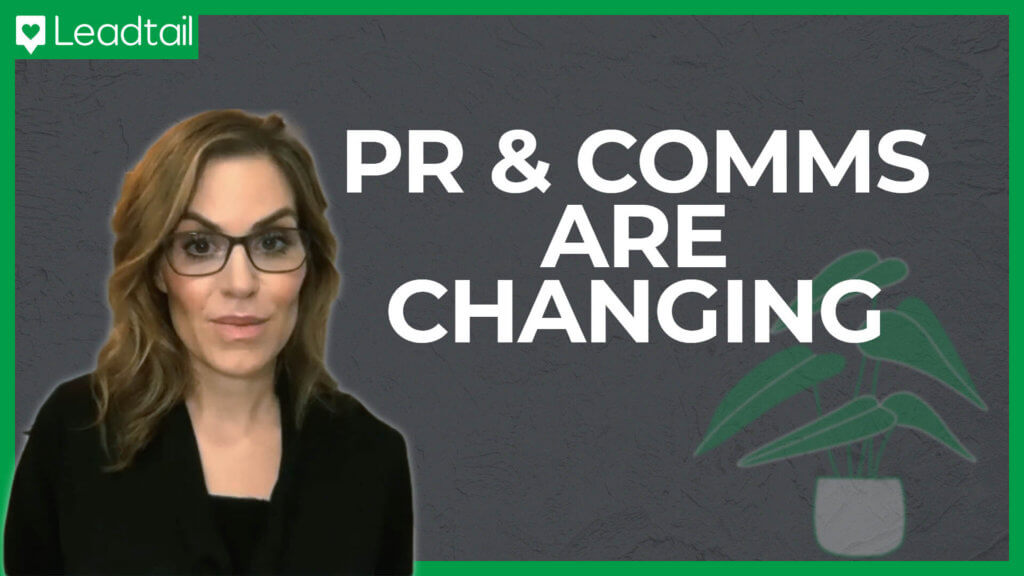How do corporations communicate with consumers 12 months after society almost split apart?
They begin by being good.
A year after the pandemic surged and protests spiralled, people now expect companies to be good — and do good. And public relations and communications teams need to communicate this goodness.
“They need to communicate positive social change,” says Robyn Hannah, Senior Director of Global Communication at Dynamic Signal, when presenting at Leadtail’s recent “Spirited Conversations” virtual event.
Robyn, an internal and external communications expert, reveals four developments that rocked the PR panorama over the last year:
- Societal expectations
- Employee expectations
- Digital transformation
- Social media
These changes have pushed brands to reinvent themselves. Brands have become softer, kinder, gooder. Post-pandemic and post-riots, there’s been a strong shift to “human-to-human” marketing.
“The stakes are bigger than they’ve ever been before,” adds Robyn. “The stakes are human.”
Narratives of Good vs. Bad
2020 was one hell of a year. It all started with COVID, which almost tore PR into two. As the pandemic infiltrated news cycles and social media feeds, there was a drastic digital transformation, and comms teams struggled to get heard.
But something happened that made their voices stronger.
After the rioting and police brutality protests that ensued, consumers craved value-driven companies. There was a paradigm shift where customers sought out brands that did “good” — those that welcomed diversity and treated employees well.
So PR teams shouted louder about these social issues.
Consumers now perceive companies that express the values of diversity, equality, and social justice as good. Companies with horrible histories — those with a lack of diversity, questionable ethics, or problematic workplace policies — were bad. (Robyn refers to them as the “heroes” and the “zeroes.”)
And it was up to PR and comms to drive narratives of ‘good versus bad’ — or face the wrath of a social media mob.
Robyn says 2020’s most successful brands focused on people, became anchored by purpose, and were driven by values. That framework influenced their contacts, communications, and campaigns.
Those that didn’t focus on people, purpose, and values?
Customers cancelled them.
“After the cries for social justice last spring, we saw so much going on with cancel culture and how companies were called out for the way they treated employees. Whether they were protecting them or paying them fairly or providing healthcare,” says Robyn.
Eighty percent of consumers prefer to buy from companies that treat employees well, and 83 percent agree brands should create workplaces that welcome diversity, according to research from Dynamic Signal. So PR teams need to continue to communicate these values in 2021 and beyond.
“It’s really about how a company applies its values and how employees experience those values because they’re going to tell the world about how they’re being treated. And social media amplifies all of this.”
Good PR = Good Sales
Seventy percent or more of U.S. adults say a brand’s treatment of employees, customers, and society influences purchasing decisions, as per Dynamic Signal.
Society has changed its expectations, and sales have become intrinsically linked to how brands behave. And consumers trust companies more when they are on their best behavior.
“Businesses are a significantly trusted institution,” says Robyn. “The public holds us accountable. So that has a different implication for how we structure our PR, marketing, and communications.”
The Future of PR and Comms in a New World
Companies have responded to the new value-driven marketplace, with marketing spend shifting from glossy ad campaigns to social awareness. The bottom line? Brands want customers to see them as do-gooders.
Whatever their intentions, brands now must take a stand on social issues and other cultural hot potatoes. It goes back to those four changes Robyn mentioned: Societal expectations, employee expectations, digital transformation, and social media.
“All these have shifted the way we plan our PR and communications activities,” says Robyn. “They’ve eroded the silos between HR comms, internal comms, marketing, branding, and media relations. That was happening before, but the pandemic accelerated it.”
Watch Robyn’s presentation here.
If you’d like to attend one of our monthly Spirited Conversations events, keep an eye on LinkedIn to register.
Want to have a conversation about social media? Let’s talk.
